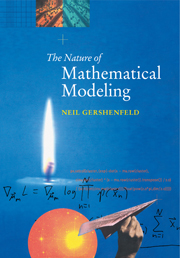The Nature of Mathematical Modeling
£47.99
- Author: Neil Gershenfeld, Massachusetts Institute of Technology
- Date Published: June 2011
- availability: Available
- format: Paperback
- isbn: 9780521210508
£
47.99
Paperback
Looking for an inspection copy?
This title is not currently available on inspection
-
This 1998 book, about the nature and techniques of mathematical modeling, is oriented towards simple efficient implementations on computers. The text is in three sections. The first covers exact and approximate analytical techniques; the second, numerical methods; the third, model inference based on observations; and the last, the special role of time in modeling. Each of the topics in the book would be the worthy subject of a dedicated text, but only by presenting the material in this way is it possible to make so much material accessible to so many people. Each chapter presents a concise summary of the core results in an area, providing an orientation to what they can (and cannot) do, enough background to use them to solve typical problems, and pointers to access the literature for particular applications. The text is complemented by extensive worked problems.
Read more- Unique summary of all of modern mathematical modeling methods
- Author from the world-famous Center for Bits and Atoms at MIT
- Appropriate as text/reference work for students and researchers in any quantitative or semi-quantitative subject area
Reviews & endorsements
Review of the hardback: 'Simulation and mathematical modelling will power the 21st century the way steam powered the 19th. Gershenfeld masterfully compresses two armloads of dense textbooks into a single clear volume, including both classic and avant garde methods, and with well-selected references for further study. Every student of computing needs this book as the entry ticket into a vital and rapidly-changing field.' William H. Press, Harvard University, author of Numerical Recipes
See more reviewsReview of the hardback: 'Reducing whole disciplines to 10 pages or so of essential ideas makes for a remarkable guidebook. Virtually every present-day technique for modeling systems is displayed, like so many tools hung on a pegboard … anyone who wants a sense of how the language of mathematics has changed in the last 50 years will marvel at Gershenfeld's concise map.' The Boston Globe
Review of the hardback: 'In a compact but accessible manner, Gershenfeld offers a wide-ranging overview of mathematical ideas and techniques that provide a number of effective approaches to problem solving ... The Nature of Mathematical Modeling is a great compendium of techniques. It should be kept within easy reach of anyone who wants to build computer models to help understand the world around us.' Science
Review of the hardback: 'Each topic described deserves a book in its own right, however, the author has skillfully pulled together a concise summary of each introducing basic results and building on them … Each time I thumbed through the text I found something of interest which was well written and frequently presented a new perspective on a known subject … I found this book a pleasure to read … and recommend it as good background reading material on the broad subject of mathematical modeling. This not only includes students but also possibly for managerial purposes where a deep knowledge of a subject may not be required but an overview with the basic principles explained.' Christopher Dean, Mathematics Today
Review of the hardback: 'Professor Gershenfeld's book is praiseworthy for being a concise account of a wide range of subjects and methods dealing with mathematical modelling as well as numerical treatment of models and governing equations with the aid of computers … This is a remarkable achievement, taking into account the wealth of subjects that Gershenfeld has succeeded in considering in this space … To conclude, I wholeheartedly recommend this book to both students and professional scientists … I have read the entire book with utmost pleasure and satisfaction.' Contemporary Physics
Review of the hardback: 'This is a well-written and interesting book. It would make an excellent text for a final-year undergraduate course in modeling and a good reference for research students in any situation where data are to be examined.' A. D. Booth, Simulation and Modeling
Review of the hardback: 'The book contains a wealth of basic ideas and methods of the fantastic world of mathematical modeling … presented in a compact and self-contained way … a good introduction to the subject …'. N. D. C. Veraverbeke, ISI Short Book Reviews
Review of the hardback: 'The book offers a useful; insight into modelling with mathematical modelling and computer implematation its main concern. The author achieves his aim; of producing a well-written account of the simple and efficient ways in which such models can be implemented.' Kybernetes
Customer reviews
Not yet reviewed
Be the first to review
Review was not posted due to profanity
×Product details
- Date Published: June 2011
- format: Paperback
- isbn: 9780521210508
- length: 358 pages
- dimensions: 244 x 170 x 19 mm
- weight: 0.57kg
- availability: Available
Table of Contents
Preface
1. Introduction
Part I. Analytical Models:
2. Ordinary differential and difference equations
3. Partial differential equations
4. Variational principles
5. Random systems
Part II. Numerical Models:
6. Finite differences: ordinary difference equations
7. Finite differences: partial differential equations
8. Finite elements
9. Cellular automata and lattice gases
Part III. Observational Models:
10. Function fitting
11. Transforms
12. Architectures
13. Optimization and search
14. Clustering and density estimation
15. Filtering and state estimation
16. Linear and nonlinear time series
Appendix 1. Graphical and mathematical software
Appendix 2. Network programming
Appendix 3. Benchmarking
Appendix 4. Problem solutions
Bibliography.
Sorry, this resource is locked
Please register or sign in to request access. If you are having problems accessing these resources please email [email protected]
Register Sign in» Proceed
You are now leaving the Cambridge University Press website. Your eBook purchase and download will be completed by our partner www.ebooks.com. Please see the permission section of the www.ebooks.com catalogue page for details of the print & copy limits on our eBooks.
Continue ×Are you sure you want to delete your account?
This cannot be undone.
Thank you for your feedback which will help us improve our service.
If you requested a response, we will make sure to get back to you shortly.
×







